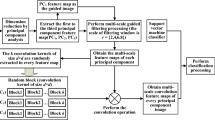Abstract
In order to reduce the number of bands for processing hyperspectral remote sensing data and to improve the processing efficiency, this article proposed a decision tree classification method based on minimum noise fraction (MNF) transform. MNF transform was used to reduce data redundancy, and the image noise was separated. By analyzing the MNF eigenvalues of the ground objects, the classification decision tree was established, and the information such as the relative thickness of the oil film was extracted. The results show that the method can ensure recognition accuracy, and achieve the efficient use of information of spectral dimension. Meanwhile, the data processing time is significantly reduced, which is very important during emergency response to oil spills.






Similar content being viewed by others
References
Boardman, J. W., & Kruse, F. A. (1994). Automated spectral analysis: a geological example using AVIRIS data, north Grapevine Mountains, Nevada. In Proceedings, ERIM Tenth Thematic Conference on Geologic Remote Sensing (pp. I–407 – I–418). Ann Arbor, MI: Environmental Research Institute of Michigan.
Bradley, E. S., Roberts, D. A., Dennison, P. E., Green, R. O., Eastwood, M., Lundeen, S. R., et al. (2011). Google earth and google fusion tables in support of time-critical collaboration: mapping the deepwater horizon oil spill with the AVIRIS airborne spectrometer. Earth Science Informatics, 4(4), 169–179.
Brekke, C., & Solberg, A. H. S. (2005). Oil spill detection by satellite remote sensing. Remote Sensing of Environment, 95(2005), 1–13. doi:10.1016/j.rse.2004.11.015.
Exelis Visual Information Solutions, I. (2005). Envi Classic Help.
Green, A. A., Berman, M., Switzer, P., & Craig, M. D. (1988). A transformation for ordering multispectral data in terms of image quality with implications for noise removal. IEEE Transactions on Geoscience and Remote Sensing, 26(1), 65–74.
Green, R. O., Eastwood, M. L., Sarture, C. M., Chrien, T. G., Aronsson, M., Chippendale, B. J., et al. (1998). Imaging spectroscopy and the airborne visible/infrared imaging spectrometer (AVIRIS). Remote Sensing of Environment, 65(3), 227–248.
Joye, S. B., MacDonald, I. R., Leifer, I., & Asper, V. (2011). Magnitude and oxidation potential of hydrocarbon gases released from the BP oil well blowout. Nature Geoscience, 4(3), 160–164.
Li, H.-T., Gu, H., Zhang, B., & Gao, L.-R. (2007). Research on hyperspectral remote sensing image classification based on MNF and SVM. Remote Sensing Information, 26(5), 12–15.
Plaza, J., Pérez, R., Plaza, A., Martínez, P., & Valencia, D. (2005). Mapping oil spills on sea water using spectral mixture analysis of hyperspectral image data. Proceedings of SPIE, 5995, 1–8. doi:10.1117/12.631149.
Salem, F. (1998). Hyperspectral remote sensing A new approach for oil spill detection and analysis. George Mason University.
Sanchez, G., Roper, W. E., & Gomez, R. (2003). Detection and monitoring of oil spills using hyperspectral imagery. Proceedings of SPIE, 5097, 233–240.
Shahsavarhaghighi, S., Sahebi, M. R., Valdanzoej, M. J., & Haddadi, G. A. (2013). A comparison of IEM and SPM model for oil spill detection using inversion technique and radar data. Journal of the Indian Society of Remote Sensing, 41(2), 425–431. doi:10.1007/s12524-012-0217-4.
Solberg, A. H. S. (2012). Remote sensing of ocean oil-spill pollution. Proceedings of the IEEE, 100, 2931–2945. doi:10.1109/JPROC.2012.2196250.
Srivastava, H., & Singh, T. P. (2010). Assessment and development of algorithms to detection of oil spills using MODIS data. Journal of the Indian Society of Remote Sensing, 38(1), 161–167. doi:10.1007/s12524-010-0007-9.
Svejkovsky, J., Lehr, W., Muskat, J., Graettinger, G., & Mullin, J. (2012). Operational utilization of aerial multispectral remote sensing during oil spill response: lessons learned during the Deepwater Horizon (MC-252) spill. Photogrammetric Engineering and Remote Sensing, 78(10), 1089–1102.
Tong, Q., Zhang, B., & Zheng, L. (2006). Hyperspectral remote sensing—principles, techniques and applications. Beijing: Higher Education Press.
Acknowledgments
This work is supported by the Fundamental Research Funds for the Central Universities (Grant No. 3132015006), the National Natural Science Foundation of China (Grant No. 51509030) and Natural Science Foundation of Liaoning Province (Grand No. 201502886). The authors would also like to thank Associated Professor Long MA for collecting the imagery.
Author information
Authors and Affiliations
Corresponding author
About this article
Cite this article
Liu, B., Li, Y., Chen, P. et al. Extraction of Oil Spill Information Using Decision Tree Based Minimum Noise Fraction Transform. J Indian Soc Remote Sens 44, 421–426 (2016). https://doi.org/10.1007/s12524-015-0499-4
Received:
Accepted:
Published:
Issue Date:
DOI: https://doi.org/10.1007/s12524-015-0499-4




